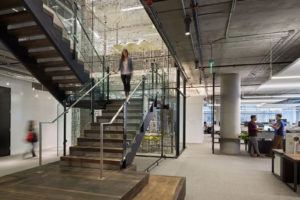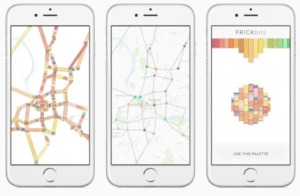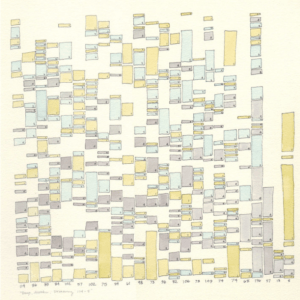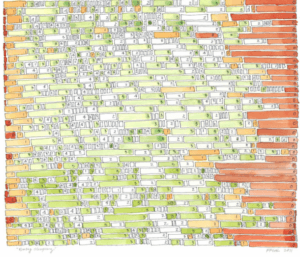Data Art: Transforming Personal Data into Digital Fingerprints

Art can many times be used as a powerful tool to helps us find meaning in mass amount of data that is available in the world.
As the amount of data that is being collected continues to grow at an exponential speed, it has become increasingly difficult for top executives to distill customer data into actionable insights. Furthermore, average citizens are wary of releasing their personal information to the government and companies due to privacy and security concerns. To address some of these problems, artist Laurie Frick decided to transform personal data into art as a way to help people understand abstract information in an intuitive way. Furthermore, Laurie hopes that her art work will inspire people to take ownership of their personal data by creating digital fingerprints, or “data selfies” that can help more accurately express who they are as complex and unique individuals.
Unlike most artists, Laurie spent the first 20 years of her professional life in the tech industry. As a co-founder of a software company and previous employee of HP and Compaq, Laurie has a deep understanding of the types of challenges that businesses face with big data analyses and visualization. Now working as a “data artist”, Laurie collaborates with tech companies like Samsung, Google, and IBM to create out-of-the-box applications for big data to help senior executives better understand how consumers really think and behave[i].


For example, above is one of Laurie’s pieces featuring her walking routine over a period of time. Laurie used GPS and a time lapse camera to record her location, frequency of visits, and level of congestion on the streets. Each line below signifies a specific route that she took through the city, with the thickest lines representing the most frequent paths. The installation is displayed in a big-data company in San Francisco[ii] to showcase the creatives ways for companies to visualize mass amount of consumer data.

Aside from helping companies find data insights through imaginative solutions, Laurie Frick also uses data-inspired art pieces to bring social awareness to challenging issues. In the installation above, Laurie used data from 264 patients gathered from a Neuromuscular clinic to map out the stages of ALS disease[iii]. Using a series of color-coded wooden blocks and handwritten citations, Laurie was able to find patterns in the 7 levels of severities seen across 6 categories of ALS symptoms. The installation, which was displayed at a Medical Center in Charlotte, is used as an emotion vehicle to bring awareness to the general public of the tragic realities of ALS[iv].

Finally, Laurie hopes that her artwork will also be able to inspire individuals to embrace their personal data and use it to create artistic self-expressions that define who they are. By collaborating with a creative design agency, thirteen23, Laurie created an app called FRICKbits (above) that users to create data-portraits of themselves[v] through personally-tracked data. This initiative is part of “the Quantified Self” movement, which was first started by Gary Wolf and Kevin Kelly in 2007. The goal of the movement is to encourage individuals to better understand themselves through routinely tracked data such as daily moods, activity levels, sleeping patterns, food consumption and even social interactions[vi]. Through these rich data points, individuals can create “data selfies” that are shareable and only unique to them. These artistic representations are an effective way for people to better understand one and another in dimensions that hard to express in words or numbers. For example, Laurie created data portraits from her and her husband’s sleep patterns over a span of one month. The amount of white space below represents the percentage of time that a person is in light sleep mode. Through the comparing the two drawings between her sleeping pattern (top) and her husband’s (bottom), it is immediately clear that her husband may have a sleep-depravation problem. Data-portraits can therefore not only be a powerful and emotional tool to understand people on a deeper level but also be call-to-action for mental and physical wellness.


Endnote:
[i] https://www.theatlantic.com/entertainment/archive/2015/05/the-rise-of-the-data-artist/392399/
[ii] http://www.lauriefrick.com/blog/floating-data-piece-during-installation
[iii] http://www.lauriefrick.com/7-stages/egi0zc50u3azs46r17l6ukx4o1cjsm
[iv] http://www.lauriefrick.com/7-stages/c8i6vh6lb0uusrjtnabjt65d51ns1o
[v] https://medium.com/hello-thirteen23/frickbits-b55dd906028d
[vi] https://www.economist.com/node/21548493



I wonder if data “footprints” like the ones Laurie captures via the app will become a key source of identification in the future. Your post also highlights the importance and power of data visualization to draw insights from the data. As we’ve learned in class, the data itself isn’t enough on its own, but requires someone to contextualize it. One of the dangers of the app, however, is that people may try to self-diagnose without fully understanding how to correctly or effectively interpret the data. This reminds me a bit of companies like 23andMe that offer genetic testing to individuals that can easily be misconstrued. In addition, I wonder if Laurie has been approached by companies interested in the data she is collecting from users of the app.
Cathy – this is such an interesting article! I fully agree that how to communicate insights from the data is getting more important as the quantity and complexity of data increases exponentially. I really like the idea that using arts as a way of communicating such insights, and the examples you showed in this article is powerful. I also hope that big data gives some inspiration to artists and there are more collaboration between data scientists and artists to make use of the data and communicate them effectively.